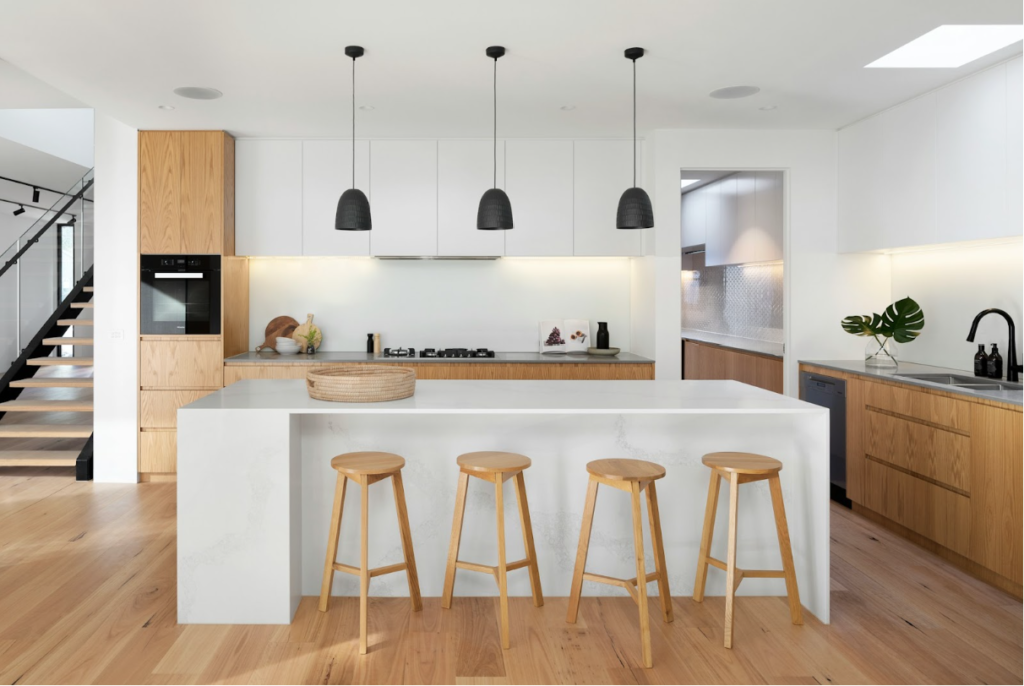At the center of every household is a place where people come together to prepare delicious meals and make cherished memories – the kitchen. Amidst all the features of a well-designed kitchen, the unassuming kitchen island stands out as a versatile and essential feature.
Whether you’re renovating your existing kitchen or planning a new one, choosing the right kitchen island can make spending time in your kitchen a joy.
Discover the essential factors, styles, and features that will guide you through the vast array of kitchen islands, allowing you to find the ideal one that suits your needs and complements your lifestyle.
Regarding kitchen islands, it’s important to recognize that they offer more than just a practical purpose. They create a stylish and practical kitchen space by combining design, storage, and functionality.
Whether you are someone who enjoys cooking at home, someone who loves to host events or someone who needs extra storage and workspace, this blog is designed to help you make informed decisions every step of the way.
The first step to deciding which kitchen island is suitable for your space is to take a good look at the space you have (or will have). This involves considering the room’s layout, dimensions, and overall functionality.
To do this, you’ll need to:
Measure the available space
Measure both the length and the width of the kitchen, and take note of any corners, doorways, or other obstacles that might affect your layout. Remember to include the space needed to move comfortably around the island.
Study your current (or proposed) layout
When designing a kitchen, it’s important to identify the primary work zones. These zones typically include areas for cooking, preparation, and cleaning. Understanding these work zones allows you to create a layout that meets your needs.
Evaluate how the island will affect traffic flow within these work zones. You don’t want the island to disrupt the functionality of the kitchen. Instead, you want it to enhance the workflow and convenience.
Before adding an island, determine its main purpose. Will it be used for cooking, additional storage, or a seating area? By defining the island’s main purpose, you can ensure that it meets your needs and fits seamlessly into the design of your kitchen.
Finally, position the island strategically to optimize workflow and convenience in your kitchen.
For example, if the island is primarily for cooking, it should be near the cooking work zone. It should be positioned near the preparation work zone if it’s mainly for storage.
Consider “traffic flow”
It’s important to consider the placement of the island carefully. One key consideration is ensuring that the island placement does not obstruct natural traffic patterns in the kitchen. After all, the kitchen is a high-traffic area, and you don’t want the island to get in the way of people moving around freely.
Another important factor is allowing enough space between the island and other kitchen elements for easy movement. This includes cabinets, appliances, and the dining area if there is one.
By leaving enough space around the island, you can ensure that people can easily move in and out of the kitchen, grab items from the cabinets or fridge, and work comfortably at the island without feeling cramped or crowded.
Taking the time to carefully consider the placement and spacing of your kitchen island can make a big difference in its functionality and flow. By prioritizing ease of movement and traffic flow, you can create a space that is beautiful, practical, and user-friendly.
Consider the aesthetics – explore different styles
Kitchen islands can vary from traditional to modern and multifunctional designs, each with unique features and benefits.
Explore kitchen island styles to choose the one that complements your kitchen’s design and your personal taste.
Consider factors such as size, shape, materials used, and the island’s intended function to make the right choice that enhances your kitchen’s functionality and visual appeal.
Material selection
When selecting a countertop material for your kitchen island, aesthetics and functionality should be top of mind.
Some popular options include granite, quartz, and butcher block, each with its own unique advantages and disadvantages. Granite is a highly durable and heat-resistant material that comes in a wide range of colors and patterns.
At the same time, quartz is equally durable but offers a more consistent appearance and requires less maintenance. Butcher block is a great choice for those who enjoy a more rustic or traditional look and feel.
However, the material of your kitchen island is just as important as the countertop itself. Choosing a base material that is durable and easy to maintain, such as wood or stainless steel, is recommended.
Not only will these materials hold up against daily wear and tear, but they can also add a sleek and modern look to your kitchen. So, when selecting your kitchen island base material, consider its functionality and aesthetic appeal.
Make the most of storage solutions
To enhance the usefulness of your kitchen island, it’s important to include intelligent storage solutions such as pull-out shelves and concealed compartments.
These features can help you arrange your kitchen essentials effectively and maximize the island’s functionality. By installing a storage system that works for you, you can have all your cooking tools and equipment easily accessible, which can make your kitchen more efficient and enjoyable to use.
Are you adding seating?
When designing an island for your kitchen, it’s important to consider whether you want to incorporate seating into the design. If you decide to add seating, determine how many seats you’ll need and what type of seating will complement the island’s design.
Some popular options include barstools or chairs, which come in various styles and materials to suit any kitchen aesthetic. Consider factors such as comfort, durability, and ease of maintenance.
Add plenty of light
Finally, consider lighting over your island. Choose a pendant or overhead lighting that enhances both functionality and ambiance. Consider under-cabinet lighting for focused task areas on the island.
When choosing your kitchen island, remember that it should reflect your lifestyle and cooking goals. Your decisions about storage, materials, and lighting will all contribute to the overall feel of your kitchen.



